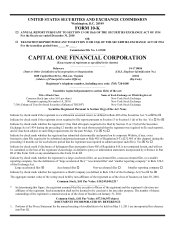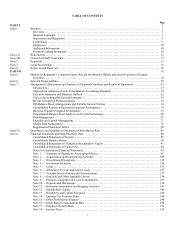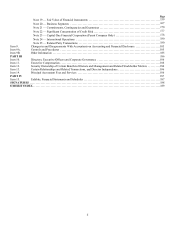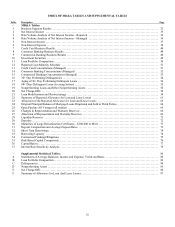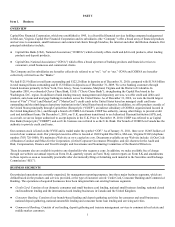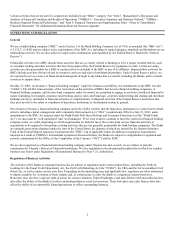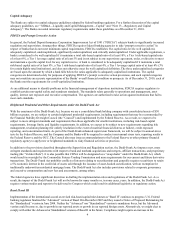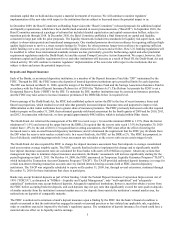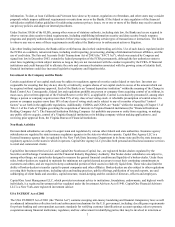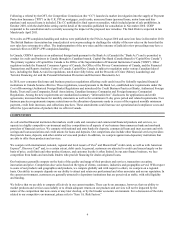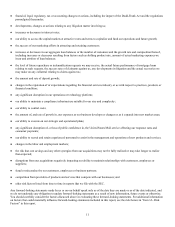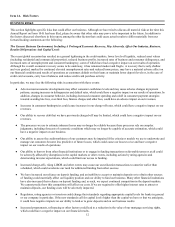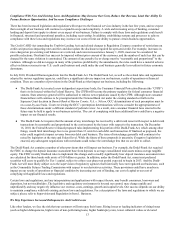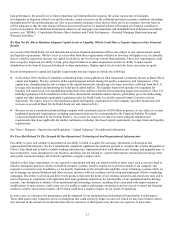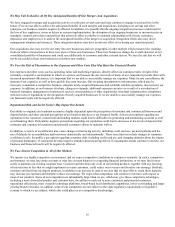Capital One 2010 Annual Report Download - page 26
Download and view the complete annual report
Please find page 26 of the 2010 Capital One annual report below. You can navigate through the pages in the report by either clicking on the pages listed below, or by using the keyword search tool below to find specific information within the annual report.6
Overdraft Protection
The Federal Reserve amended Regulation E on November 12, 2009, to limit the ability to assess overdraft fees for paying ATM and
one-time debit card transactions that overdraw a consumer’s account, unless the consumer opts in to such payment of overdrafts. The
new rule does not apply to overdraft services with respect to checks, ACH transactions, or recurring debit card transactions, or to the
payment of overdrafts pursuant to a line of credit or a service that transfers funds from another account. We are required to provide to
customers written notice describing our overdraft service, fees imposed and other information, and to provide customers with a
reasonable opportunity to opt in to the service. Before we may assess fees for paying discretionary overdrafts, a customer must
affirmatively opt in, which could negatively impact our deposit business revenue. The new rule was effective for all new accounts
opened on or after July 1, 2010, and on August 15, 2010, it became effective for accounts opened prior to July 1, 2010.
Source of Strength and Liability for Commonly-Controlled Institutions
Under the regulations issued by the Federal Reserve, a bank holding company must serve as a source of financial and managerial
strength to its subsidiary banks (the so-called “source of strength doctrine”). The Dodd-Frank Act codified the source of strength
doctrine, directing the Federal Reserve to require bank holding companies to serve as a source of financial strength to its subsidiary
banks.
Under the “cross-guarantee” provision of the Financial Institutions Reform, Recovery and Enforcement Act of 1989 (“FIRREA”),
insured depository institutions such as the Banks may be liable to the FDIC with respect to any loss incurred, or reasonably anticipated
to be incurred, by the FDIC in connection with the default of, or FDIC assistance to, any commonly controlled insured depository
institution. The Banks are commonly controlled within the meaning of the FIRREA cross-guarantee provision.
FDIC Orderly Liquidation Authority
The Dodd-Frank Act provided the FDIC with liquidation authority that may be used to liquidate a financial company if the Treasury
Secretary, in consultation with the President, based on the recommendation of the Federal Reserve and another federal agency,
determines that doing so is necessary to mitigate serious adverse effects on U.S. financial stability. Upon such a determination, the
FDIC would be appointed receiver and must liquidate the company in a way that mitigates significant risks to financial stability and
minimizes moral hazard. The costs of a liquidation of a financial company would be borne by shareholders and unsecured creditors
and then, if necessary, by risk-based assessments on large financial companies. The FDIC is issuing rules implementing this authority.
FFIEC Account Management Guidance
On January 8, 2003, the Federal Financial Institutions Examination Council (“FFIEC”) released Account Management and Loss
Allowance Guidance (the “Guidance”). The Guidance applies to all credit lending of regulated financial institutions and generally
requires that banks properly manage several elements of their lending programs, including line assignments, over-limit practices,
minimum payment and negative amortization, workout and settlement programs, and the accounting methodology used for various
assets and income items related to loans.
We believe that our account management and loss allowance practices are prudent and appropriate and, therefore, consistent with the
Guidance. We caution, however, the Guidance provides wide discretion to bank regulatory agencies in the application of the Guidance
to any particular institution and its account management and loss allowance practices. Accordingly, under the Guidance, bank
examiners could require changes in our account management or loss allowance practices in the future, and such changes could have an
adverse impact on our financial condition or results of operation.
Privacy and Fair Credit Reporting
The GLBA requires a financial institution to describe in a privacy notice certain of its privacy and data collection practices and
requires that customers or consumers, before their nonpublic personal information is shared, be given a choice (through an opt-out
notice) to limit the sharing of such information about them with nonaffiliated third parties unless the sharing is required or permitted
under the GLBA as implemented. We and the Banks have written privacy notices that are available through our website, the relevant
legal entity or both, and are delivered to consumers and customers when required under the GLBA. In accordance with the privacy
notices noted above, we and the Banks protect the security of information about our customers, educate our employees about the
importance of protecting customer privacy and allow our customers to remove their names from the solicitation lists used and shared
with others by us and the Banks to the extent they use or share such lists. We and the Banks require business partners with whom we
share such information to have adequate security safeguards and to abide by the redisclosure and reuse provisions of the GLBA. To
the extent that the GLBA and the FCRA require us or one or more of the Banks to provide customers and consumers the opportunity
to opt out of sharing information, then the relevant entity or entities provide such options in the privacy notice. In addition to adopting
federal requirements regarding privacy, the GLBA also permits individual states to enact stricter laws relating to the use of customer



